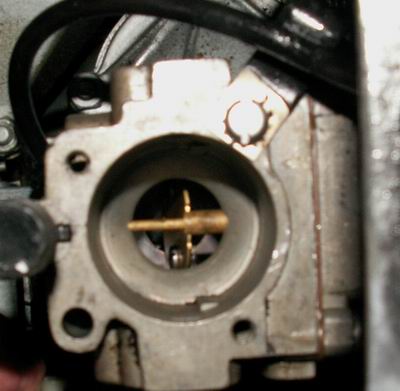
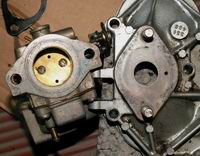
In this picture you can see the "strangled" inlet in the center of the carburetor on a 20 hp motor. On the right picture you can see different bore between the carburetor an the manifold inlet.
I myself have increased the power on my 1984 years 20 hp Evinrude outboard motor.
It took a couple of evenings to do the work.
Background.
I had read that many outboard motors actually are identical, but that manufacturers used to limit the power on some of them just to be able to deliver many power options without having to manufacture many different motors.
I checked my 20 hp evinrude part number list, and compared it with a 25 hp list, and found out that the only part that differed, from a 25 Hp motor, was the manifold inlet just under the carburetor. The manufacturer had substituted the full bore inlet with a limited bore inlet. If I could bore my manifold inlet I assumed that I would get full power from my motor.


In this picture you can see the "strangled" inlet in the center of the carburetor on a 20 hp motor. On the right picture you can see different bore between the carburetor an the manifold inlet.
I dissembled the carburetor.
I used a circle template to mark up the new hole circle on the manifold inlet. I used same diameter as the diameter on the carburetor.
I used a miniature high speed drilling machine to grind the hole. I used a chinese made grinding material kits for this work. The material in the manifold inlet is some form of aluminum so the grinding work is easy to do. Unfortunately I have no pictures from the grinding.
I did some extra work with grinding the manifold air channels to fit better against the manifold inlet. I guess that this extra work gave me a couple of extra horse powers. This extra grinding was the most time consuming moment in the whole work an it did also make the work, to manufacture a new sealing, more time consuming.
Making a new sealing.
This is how the grinded manifold looked like.
You can also see me cutting out a new sealing on this picture. First I used a scissor to roughly cut out a a piece of the sealing material. Then I marked up where the holes should be located and used a hole plunge to cut them out. I secured the sealing material against the manifold inlet, with plastic plugs in the holes, and did cut out the coutures of the sealing with a model knife. Maybe there are better methods to make a sealing but this worked for me. I used a paper material of about 0,7 mm. thickness for the sealing.
It should be resistant to quite high temperatures. I guess that we get up to 100 deg. Celsius on this motor parts..
Making holes in the sealing.
The finished parts.
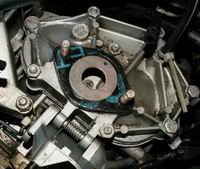
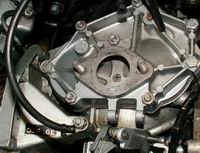
This is a picture of the inlet bore before and after modification.
The bore after modification is exactly the same as for the carburetor.
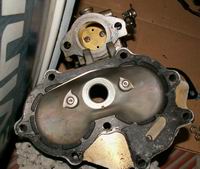
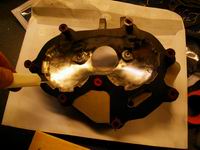
An other pair of pictures before and after modification.
How did it turn out .
I do only have practical experience from running the motor so that's what I can share with you.
I have a small Theri 415 built around 1980 in Finland. The weight is around 230 kg including motor. I have installed a 10"x13" propeller on the motor. We were 4 persons in the boat and the boat constantly run in 22 knots read on a gps. That is quite good and I believe that this motor gives a couple of more hps then a standard 25 hp motor delivers.
I hope that my experience may be to some use to inspire other to do this modification.